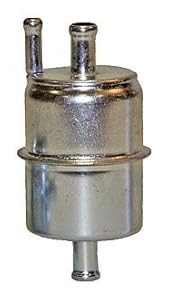The car was running good, then like it was starving for fuel again, when warm, it would run prob 20 miles without a prob, then just like die, and start again a second or two later. I pulled into a gas station, pulled the fuel line at the pump, delivery side, and a blast of gaseous air came gushing out! Then it dribbled fuel. I figured that was the vapor lock "unlocking".
So I put it back together, drove it, in the cool of the evening, 40 more miles with no hick-ups.
I have to check to see if there is a return line on my sending unit that is non-operational. The car ran great for years just the way it is, but I seldom drove it over long periods like I have been lately. I figure it's getting hotter than it has before, even though I have a 160 thermostat in it. And it's not even summer!! Yikes!
I hope there is a return line I can hook up. But, what kind of return line do you use? Like put a rubber 1/4" fuel line coming from the small port on the filter to the port on the sending unit with a 1/4" steel line between them?
Thanks, that will probably solve the issue. If not, I'll let you know.
Let's think about this; You are saying there is pressurized air between the pump and the carb. How did it get there? This is a three-part diagnostic problem.
1)The pump sucked it up. And 2), the float valve kept it in there.And 3),It's not actually air but gas in vapor form,and it cooked in that steel line, and was trapped there.
It was pressurized. That means the float valve had to be closed.So either the floatbowl was full of fuel, or the valve was stuck closed. There are two ways for this to happen; A) air entered into the line somewhere, or B)the air wasn't actually air, but gaseous fuel.
As to A);there are several places for this to occur. There are two rubber jumpers. There is the hard-line itself. And then there is the in-tank pick-up, which would have to be submerged in fuel.
As to B);when the fuel changes pressure, it tends to dissociate and form pockets of gas in vapor form.This can happen anytime fuel is pulled through a restriction. That's how a carb works. But it's not supposed to happen in the hard line. Unless it is restricted by rust. The vaporous gas will go back into a liquid state, under pressure, so after it exits the fuel pump, it should again be liquid.
Unless it is cooking in the line.
Winter fuel is easier to cook than summer gas.Winter fuel wants to be in vapor form. So check the temp of that steel line from the pump to the carb.If its running at rad temp, thats a problem. You may need to insulate the pipe.
If it happens again, check for liquid fuel at the supply side of the pump. Air here means the pump sucked it up.
But really, that pressurized "air", should not have been trapped in there, as the liquid in the bowl got burned up, the float should have dropped, and let it pass through the valve and out the bowl vent. About the only scenario I could come up with, is that the engine was running properly when shut off, and that the fuel cooked in the line, before you got a chance to remove the bottom of the line, or it flashed to vapor, the second you released the pressure.

















